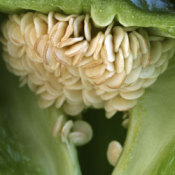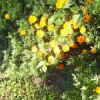 Collecting seeds from vegetables is all a matter of timing. If you pick your seeds too early, before they've had time to mature, they'll be thin and unsubstantial and lack the necessary food stores to survive winter storage, let alone start healthy new seedlings. On the other hand, if you wait too long to collect seeds, you risk losing them to the elements or you end up with seeds predisposed to producing late in the season. Here are a few tips for collecting and saving various vegetable seeds.
Collecting seeds from vegetables is all a matter of timing. If you pick your seeds too early, before they've had time to mature, they'll be thin and unsubstantial and lack the necessary food stores to survive winter storage, let alone start healthy new seedlings. On the other hand, if you wait too long to collect seeds, you risk losing them to the elements or you end up with seeds predisposed to producing late in the season. Here are a few tips for collecting and saving various vegetable seeds.
Eggplants & Tomatoes: Eggplants will fall off the vine by themselves when their seeds mature. Tomato seeds are ready when the fruits are slightly overripe and soft. The seeds of both of these vegetables should be scooped out and placed in a bowl of tepid water to separate the seeds from the pulp. Let the mixture stand for a few days and it will start to ferment. The seeds will then separate from the pulp and sink to the bottom. Pour off the pulp and underdeveloped seeds. Dry seeds on paper towels before storage.
Peppers: When the peppers turn color and start to shrivel the seeds are ready. To remove the seeds, slice the peppers open and scrape the seeds away from the pulp. Let them air dry before storing.
Cucumbers: Cucumbers with white spines will turn a yellowish-white when seeds are ready for collecting, and cucumbers with black spines will turn a golden brown. Cut the fruit open lengthwise and scoop the seeds and accompanying pulp into a bowl of tepid water. After sitting in water a few days, the mixture will begin to ferment and the seeds will sink to the bottom. Dry seeds on paper towels before storing.
Squash (also, Pumpkins & Gourds): Winter squash seeds are mature when the squash is ready for harvesting in the fall. Because they keep for several months after harvested, you can clean and remove the seeds as you consume them. Simply cut the squash into two and scrape out the pulps and separate the seeds by hand. Let the seeds air dry very thoroughly before storing. Summer squash should be left on the vine until the fruit has reached its full size and hardened. Follow the instructions for cucumbers to save seeds.
Muskmelon and Watermelon: The seeds of these melons are ready for collection when the melons become ripe and ready for eating. Wash seeds and dry them thoroughly before storing.
Edible seeds are from crops like corn, beans, and peas-crops where the seed is the part of plant that is eaten. Because these crops tend to hold on to their seeds longer, the collection time becomes less critical.
Peas & Beans: Leave them on the plants until the pods become dry and the seeds rattle inside.
Corn: Leave the ears on the stalks for another 4 weeks after the corn is ready for consumption. After 4 weeks, remove the ears from the stalks, peel back the husks, braid several of the husks together and hang them up for further drying. Shuck the ears when the kernels are completely dry.
This page contains the following solutions.
I save seed from peppers, cantaloupe, watermelon and the like. I dry them in paper towel then save them. When I am ready, I put them in a damp paper towel in a closed ziplock until they sprout.
Here are the questions asked by community members. Read on to see the answers provided by the ThriftyFun community.
I planted for first time in 20 years on soil that's located on top an artesian well. I had zucchini's the size of couches. How do I dry zucchini seeds? Would be interested in swapping some green beans (bumper crop there, also) for sweet corn or other. Name your offerings.
Hardiness Zone: 5a
By Kelley from Green Bay, WI

To dry zucchini seed, put them on newspaper, let sit until they are dry in the sun. Good luck.

Do you have pictures of the large zucchinis? I would like some of the seed, maybe I can grow large zucchinis.
Check out these photos.
I have read many articles on saving seed. In most all cases, when cleaning and saving seed from pulpy fruit you scoop the seed from the fruit, remove as much pulp as possible, then place seed in a bowl of water. Advice is given to skim off all floating seed and discard as they will not produce plants.
This is a page about saving cucumber seeds. You can save money on garden seeds by collecting them from this year's crop for use next year.
This is a page about saving tomato seeds. An economical way to grow vegetables next season, especially if you are OK if the second season's produce does not necessarily taste the same, is to save some seeds.